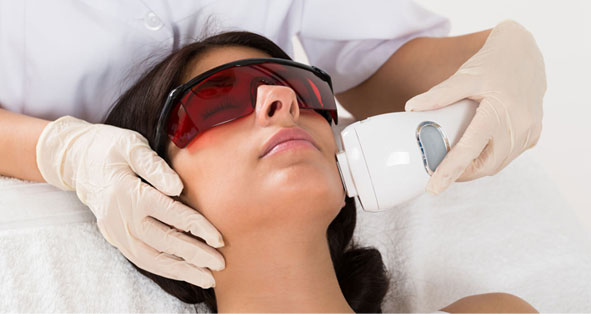
If you're not happy with shaving, tweezing, or waxing to remove unwanted hair, laser hair removal may be an option worth considering. Laser hair removal is a medical procedure that uses a laser - an intense, pulsating beam of light - to remove unwanted hair. The intense heat of the laser damages the hair follicle, which inhibits future hair growth. It typically takes multiple laser hair removal treatments to provide an extended hair-free period. Periodic maintenance treatments might be needed as well.Lasers are useful for removing unwanted hair from the face, leg, arm, underarm, bikini line, and other areas. Lasers can selectively target dark, coarse hairs while leaving the surrounding skin undamaged. Each pulse of the laser takes a fraction of a second and can treat many hairs at the same time. The laser can treat an area approximately the size of a quarter every second. Small areas such as the upper lip can be treated in less than a minute, and large areas, such as the back or legs, may take up to an hour.This technique is quite popular amid women in the present-day society, where a hair-less body epitomizes beauty and buoyancy.
Laser hair reduction is a three step procedure which involves cleaning, shaving, and scanning of the area that is to be treated. During scanning, the laser energy is passed through the skin and is absorbed by the pigment in the hair follicle.
The treatment and the sessions involved depends on the area, hair density, and the hair growth cycle that needs to be treated. Generally, a person requires six to eight sittings, and in every sitting 20% of the hair follicle gets permanently disabled.
The success of laser treatments depends on two factors: hair color and skin type. Results vary from person to person, but it effectively reduces 40 to 80% of hair.
The chance of hair growth is always there, but multiple treatments can lengthen the duration of hair loss.
Laser hair removal treatment is effective only on actively growing hair follicles. The treatments are usually spaced apart so that hair follicles take time to grow again.
It is recommended that the laser treatment should be spaced three to eight weeks apart depending on the total area covered and also on the hair growth cycle. The legs and arms usually require less frequent hair removal sessions than the neck and face regions. After the hair removal session, it usually takes two to three weeks for the hair follicles to shed off.
Laser Skin Resurfacing Or laser for Full Face
Laser skin resurfacing is a popular cosmetic procedure that can help rejuvenate the skin and reduce the effects of the sun, aging, and some facial skin disorders. Treatments are safe, effective, and convenient. Also, the cost of cosmetic laser skin resurfacing is minimal compared to many other treatment options. Learn more about how laser skin rejuvenation, or laser peel as it is often called, removes damaged outer layers of skin and stimulates the production of collagen and new skin cells in the underlying layers, bringing about smoother, younger, healthier-looking skin.
What Is Laser Skin Resurfacing?
Cosmetic laser skin resurfacing is a method for diminishing the appearance of imperfections on the skin's surface. During the laser skin resurfacing procedure a laser is used to dissolve the molecular bonds of the damaged skin cells layer by layer until a smoother, more uniform skin appearance is achieved. The procedure may also be referred to as laser skin rejuvenation because of its anti-aging benefits, or laser peel because the damaged layers of skin are peeled away.
Ideal Laser Skin Resurfacing Candidates
Laser skin resurfacing is an effective procedure for patients with lines, wrinkles, uneven pigmentation, or superficial facial scars such as acne scarring that does not respond to gentler treatments. The ideal candidate for laser skin resurfacing has elastic, non-oily skin that is not prone to scarring after minor injury. It is best that laser skin resurfacing be performed on a person who is free of any medical considerations, including prescription medication and existing health conditions that might cause unnecessary risk during the procedure or recovery period.

